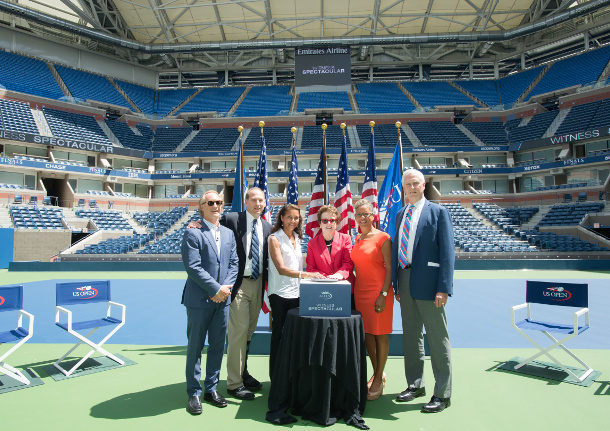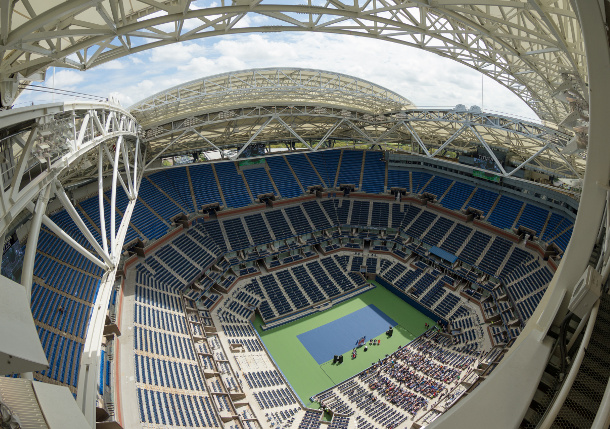By Richard Pagliaro | Tuesday, August 2, 2016
"We've created the next great iconic sports venue in New York City," said USTA Executive Director Gordon Smith of the new $150 million retractable roof over Arthur Ashe Stadium.
Photo credit: Jennifer Pottheiser/USTA
Arthur Ashe Stadium was officially crowned with its state-of-the-art lid today.
The process wasn't exactly an open and shut case.
More: Wawrinka Withdraws From Olympics
The USTA officially unveiled its $150 million retractable roof over Arthur Ashe Stadium before a group of media, sponsors and staffers.
The Doors' classic Riders on the Storm blasted over the sound system and images of past US Open rain storms flooded the four big screens inside Ashe Stadium as Jeanne Ashe, the late Hall of Famer's wife, stepped to the podium to press the ceremonial button and close the roof.
A 6,500 ton steel superstructure supports the retractable roof comprised of two polytetrafluoroethylene fabric panels moving east to west. The roof moves at a top speed of about 25 feet per minute covering the 62,500 square-foot opening—about the size of 22 tennis courts—in minutes.
When the roof is closed, Ashe Stadium is about 55 feet taller than the Statue of Liberty from base to torch.
Aesthetically, the retrofitted roof complements the brick stadium (though the blue logo of US Open sponsor Chase emblazoned across the outside roof looks a little bit cheesy). Acoustically, it will be interesting to hear how the sound of the ball off the strings mingles with the sometime buzzing and boisterous night crowds the Open attracts.
Tennis will take on a whole new sight and sound at the 2016 US Open with the completion of the three-year roof-raising project.
"We've created the next great iconic sports venue in New York City," USTA Executive Director Gordon Smith said. "The fact that you retrofitted a 24,000-seat stadium that wasn't built to hold a roof and we made it look like it was originally built that way I think it's a testament to the architects to the mechanical engineers to the contractors that it's turned out even better than we could have hoped."
The good news: It took only about six minutes for the new retractable roof to close smoothly and nearly silently.
The USTA's investment in the roof creates a more intimate atmosphere inside the 23,771-seat Ashe Stadium. LED lights illuminating in synchronicity as the sliding panels close provide bright visibility and conditions are considerably cooler and more comfortable with the roof closed. That's not because of an air conditoning system, but due to refrigerated air pumped into Ashe Stadium to maintain proper humidity.
The bad news: When you've just spent $150 million and three years building a roof that's a centerpiece of a massive $600 million rennovation to the USTA Billie Jean King National Tennis Center you'd like it to shut and re-open on cue.
While closure came quickly, it took three attempts to re-open the roof.

Wearing a red blazer Hall of Famer Billie Jean King, for whom the National Tennis Center is named after, twice pressed the button to re-open the roof behind a podium bearing the slogan "Witness Spectacular."
Spectacle led to suspense as attendees aimed cell phones skyward nothing happened creating that kind of awkward silence one can experience trapped in a stalled elevator.
"This is why we have dress rehearsals," National Tennis Center COO Danny Zausner, who was wearing a black cast on his lower left leg told the crowd.
King passed the time drumming on the podium with her palms impressively keeping the beat to U2's Beautiful Day blasting out over the sound system, while engineers in a box above the court worked to reboot the roof.
USTA President Katrina Adams joked "Roof opening take three!" before King again pressed the button. This time it worked creating a let there be light moment as Smith fist-bumped Adams in celebration.
After the ceremony, Smith said the stalled re-opening was actually a positive sign because it showed the sensor system embedded in the roof worked precisely as designed and because the process demonstrates even with a glitch the roof can be closed and re-opened in less than 10 minutes.
"There are 16 brake clamps that stop it," Smith said of the sensor system designed to ensure the roof stays on track as it moves. "One of the sensors on those 16 said I'm slightly out of alignment. It then sends a signal that says: You need to reboot and check me out to make sure I'm okay. That's what they did. They had to reboot. They checked it out and it was fine. They rebooted and it worked fine. So it was a delay but it behaved like it was designed to work."
Like a contender training for the US Open, the retractable roof will undergo daily practice workouts between now and opening day on August 29th. Smith said he doesn't expect a recurrence of today's stall pattern because it's unlikely officials would ever close and re-open the roof in a 10-minute span during the Open.
"So what are the odds of closing the roof and opening it again in an eight-minute span? It will probably never happen again in real life," Smith said. "This wasn't a real-life situation. We will be exercising it again. The worst that can happen is we have to do a reset and it takes eight minutes. It worked like it was supposed to work."

Four massive winches open and close the retractable roof, designed to be operated in wind speeds up to 50 mph.
Wind whipping off nearby Flushing Bay has created havoc in past US Open matches. Tomas Berdych called the blustery 25 mph wind gusts that blew a chair onto court "impossible" after his 2012 US Open semifinal loss to Andy Murray. Those unruly conditions were not as extreme as the sometime tennis typhoon that was the 2004 U.S. Open quarterfinal between Roger Federer and Andre Agassi.
The retractable roof will provide much calmer conditions in Ashe though it's uncertain how the closed roof will impact the spin and speed of the bounce off the court since players have yet to actually test conditions with the roof closed.
So will we see the roof closed in cases of swirling wind or extreme heat?
Probably not. The USTA says it's committed to maintaining the Open as an open-air tournament.
"We're really not closing the roof for heat purposes," Smith said. "We want this tournament to remain a test of the elements. But we need to be able to hold the tournament when it rains.
"The beauty of this is with the roof, the wind is greatly reduced. We're going to reduce the wind and have a very competitive environment with the roof open or closed."
While the USTA also envisions possibly holding future Davis Cup and Fed Cup ties on the National Tennis Center grounds, don't expect Arthur Ashe to rival Madison Square Garden, nearby Citi Field or the former US Open home at Forest Hills as a concert venue.
"There is an opportunity (for other uses of the stadium). The thing about Arthur Ashe Stadium is it has a roof over it now and it's retractable but at the end of the day in winter time it's not a climate-controlled facility so there are some limitations on it," Zausner told Tennis Now. "It was built for tennis. All the seats surround the tennis court. It's not the ideal concert venue, but we believe it's got some other uses as well as the Grandstand and the grounds."
The 2016 US Open will also debut the new 8,125-seat Grandstand Stadium.
More on the new Grandstand and other National Tennis Center changes, including the expansive new pedestrian boulevard and a new 14,000-seat Louis Armstrong with retractable roof set to open in 2018, to follow.